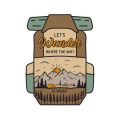1. Why Rain Gear Matters on the Trail
If you love hiking, you know that weather can change in a heartbeat—especially in the U.S., where mountain storms and sudden downpours are common. Having the right rain gear isn’t just about staying comfortable; it’s about staying safe and healthy, too.
Health and Safety: More Than Just Getting Wet
Getting soaked on the trail can quickly lead to serious problems. Here’s why staying dry matters:
| Issue | Why It Matters |
|---|---|
| Hypothermia | Even in mild temperatures, wet clothes pull heat from your body fast, increasing the risk of hypothermia. |
| Blisters & Chafing | Wet socks and clothing cause friction, leading to painful blisters and skin irritation. |
| Slips & Falls | Slick rocks and muddy trails are harder to navigate if your vision is blurred by rain or your grip is compromised. |
| Mental Fatigue | Hiking while cold and soggy drains your energy and motivation, making it harder to finish your hike safely. |
Comfort and Morale: Enjoying the Journey
No one wants their outdoor adventure ruined by being cold and uncomfortable. Good rain gear keeps spirits high, allowing you to focus on the scenery instead of counting down the miles until you’re back at the car. Staying dry means enjoying lunch breaks, taking photos, and exploring without rushing or worrying about every dark cloud overhead.
Stay Prepared for Any Forecast
Whether you’re tackling a section of the Appalachian Trail or hitting local state park trails after work, packing essential rain gear ensures you’re ready for anything Mother Nature throws your way. Next up: what exactly you need to stay dry from head to toe.
2. Choosing the Right Rain Jacket
Key Features of a Good Hiking Rain Jacket
When youre hiking in unpredictable U.S. weather, your rain jacket can make or break your outdoor adventure. The right rain jacket keeps you dry, comfortable, and ready for anything the trail throws at you. Here’s what to look for:
Waterproof Materials
A quality rain jacket should be made from waterproof materials like Gore-Tex, eVent, or similar proprietary fabrics. These materials block out rain and prevent water from soaking through, even in heavy downpours.
Breathability
Hiking often means working up a sweat. Breathable jackets let moisture escape so you don’t get clammy inside. Look for features like pit zips (underarm vents) or mesh-lined pockets that help with airflow.
Fit and Comfort
The fit matters—your rain jacket should allow room for layering but not be too baggy. Adjustable cuffs, hoods, and hemlines help seal out rain and wind while keeping you comfortable as you move.
Comparing Popular U.S. Rain Jacket Brands
| Brand | Main Features | Best For |
|---|---|---|
| Patagonia | Eco-friendly materials, reliable waterproofing, breathable designs | Sustainable hikers, general hiking |
| The North Face | Durable construction, variety of fits, great hood design | All-weather hikers, mountain trails |
| Columbia Sportswear | Affordable options, Omni-Tech waterproof fabric | Budget-conscious hikers, family outings |
| Arcteryx | Premium build quality, lightweight technical fabrics, high breathability | Serious hikers, alpine adventures |
| Outdoor Research | Pit zips for ventilation, adjustable hoods, solid waterproofing | Backpackers, wet climates |
Pro Tip:
If you’re shopping in the U.S., try on several brands to see which fits your body type best and always check if the jacket is labeled “waterproof” (not just “water-resistant”). Local outdoor retailers like REI offer great advice and let you test products before buying.

3. Waterproof Pants and Gaiters
When it comes to hiking in wet weather across the diverse landscapes of the United States—from the misty forests of the Pacific Northwest to the unpredictable Appalachian Mountains—keeping your legs and feet dry is just as important as protecting your upper body. That’s where waterproof pants and gaiters come in handy.
Why Rain Pants Matter
Rain pants act as a protective barrier, shielding your legs from rain, mud, and wind. They’re especially valuable on trails with overgrown vegetation or when trekking through tall, wet grass. The right pair keeps you comfortable and prevents chafing from soggy clothing.
Key Benefits of Rain Pants
| Benefit | Description |
|---|---|
| Stay Dry | Prevents water from soaking through to your base layers, keeping you warm and dry all day. |
| Easy Layering | Designed to pull on over hiking pants for quick protection when rain starts unexpectedly. |
| Wind Protection | Blocks cold gusts during storms or at higher elevations. |
| Packs Small | Most are lightweight and compressible, easy to stash in a backpack until needed. |
The Role of Gaiters
Gaiters are another smart addition for American hikers. These wrap around your lower legs and cover the tops of your boots, forming a barrier against water, mud, snow, and even pesky trail debris like pebbles or pine needles. They’re particularly useful for wet or muddy conditions common on many U.S. trails, or when crossing creeks and streams.
Choosing the Right Gear for American Trails
- Durability: Look for reinforced materials that can handle rocky, rugged paths found in places like Colorado or Utah.
- Breathability: In humid regions such as the Southeast, select pants and gaiters with ventilation features or breathable membranes to avoid overheating.
- Fit: Make sure rain pants fit comfortably over your hiking pants and boots. Adjustable cuffs help seal out water.
- Easy On/Off: Side zippers or snap closures allow you to put them on quickly without taking off your boots—a must if a downpour rolls in fast!
- Seasonal Use: For winter hikes or snowy trails in places like the Rockies, choose gaiters that reach higher up the calf for extra protection.
Quick Comparison: Features to Look For
| Rain Pants | Gaiters | |
|---|---|---|
| Main Purpose | Keep legs dry from rain & wind | Protect lower legs & boots from water & debris |
| Best For | Sustained rainfall, wet brush, windy summits | Muddy trails, creek crossings, snowfields |
| Packing Size | Packs small; light to midweight options available | Takes little space; always worth carrying in wet seasons |
| Cultural Tip (USA) | A favorite among thru-hikers on the PCT & AT for all-day comfort | Loved by mountain hikers and those tackling variable terrain |
Selecting reliable rain pants and gaiters means you’ll be ready for whatever Mother Nature throws your way—whether you’re hiking under Oregon drizzle or splashing through Appalachian puddles. Stay prepared so you can focus on enjoying every mile of the trail!
4. Protecting Your Head, Hands, and Feet
When it comes to hiking in the rain, keeping your head, hands, and feet dry is just as important as a good rain jacket. These areas are prone to getting wet and cold quickly, which can make your hike uncomfortable or even unsafe. Here’s how you can stay dry from head to toe with some top-rated gear that American hikers love.
Waterproof Hats
A waterproof hat shields your head from rain and helps keep water from running down your neck. Look for hats made of breathable yet water-resistant materials.
| Brand | Product | Features |
|---|---|---|
| Outdoor Research | Seattle Sombrero | Wide brim, Gore-Tex fabric, fully waterproof |
| Sunday Afternoons | Ultra Adventure Storm Hat | UPF protection, waterproof panels, packable design |
| Columbia | Bora Bora II Booney Hat | Omni-Tech waterproofing, adjustable drawcords |
Waterproof Gloves
Your hands need protection too—especially when temperatures drop. Waterproof gloves keep your fingers warm and dry so you can grip trekking poles or navigate trails comfortably.
| Brand | Product | Features |
|---|---|---|
| Sealskinz | Waterproof All Weather Glove | Tough outer shell, breathable membrane, touchscreen compatible |
| The North Face | Apex+ Etip Gloves | DWR finish, insulated, works with smartphones |
| Marmot | PreCip Eco Gloves | NanoPro fabric, lightweight and packable, grippy palms |
Waterproof Socks and Gaiters
Soggy feet are no fun on the trail. Waterproof socks add an extra layer of defense against puddles and wet grass. Pair them with gaiters for full lower-leg protection.
| Brand | Product (Socks/Gaiters) | Features |
|---|---|---|
| Darn Tough Vermont | Cushion Boot Sock (water-resistant wool) | Cushioned support, quick-drying, lifetime guarantee |
| Sealskinz | Waterproof Mid Length Sock | 100% waterproof, breathable membrane, anti-blister fit |
| PATAGONIA/Outdoor Research | Crocodile Gaiters | Tough Cordura fabric, reinforced lower legs, adjustable straps |
Quick Tips for Maximum Protection:
- Tuck jacket hoods under your hat for extra rain defense.
- Select gloves with grippy palms for better pole control.
- If you’re crossing streams or hiking through heavy brush, gaiters are a must-have.
The right gear keeps you comfortable and safe on rainy hikes. With these essentials from trusted U.S. brands, youll be ready to tackle any weather Mother Nature throws your way!
5. Additional Tips for Staying Dry
Layering: The Smart Way to Dress for Rainy Hikes
Layering is key when you’re hiking in unpredictable weather. Start with a moisture-wicking base layer that pulls sweat away from your skin, add an insulating mid-layer for warmth, and finish with a waterproof outer shell to block rain and wind. Avoid cotton, as it soaks up water and takes forever to dry. Here’s a quick guide:
| Layer | Purpose | Recommended Materials |
|---|---|---|
| Base Layer | Wicks sweat, keeps skin dry | Synthetic fibers, Merino wool |
| Mid Layer | Adds warmth | Fleece, lightweight down, synthetic insulation |
| Outer Shell | Blocks rain and wind | Waterproof/breathable fabric (Gore-Tex, eVent) |
Packing Your Rain Gear Properly
The way you pack your rain gear can make a huge difference when the sky opens up unexpectedly. Always keep your rain jacket and pants at the top or in an easy-access pocket of your backpack—don’t bury them under layers of other gear. Stash small items like a rain hat or gloves in exterior pockets so you can grab them quickly.
Backpack Rain Covers: Keeping Your Gear Dry
Your backpack needs protection too! Most American hikers use a dedicated rain cover that fits snugly over their pack. Some backpacks come with built-in covers, but aftermarket options are available in all sizes. For added peace of mind, line the inside of your backpack with a heavy-duty trash bag or use individual dry bags for electronics and clothing.
Rain Gear Quick Reference Table
| Item | Why You Need It | Packing Tip |
|---|---|---|
| Rain Jacket & Pants | Main barrier against rain and wind | Keep on top or in side pocket for fast access |
| Backpack Rain Cover | Keeps pack contents dry during heavy rain | Store in outside pocket; practice putting it on quickly before your hike! |
| Dry Bags/Trash Bag Liners | Adds extra layer of waterproofing inside your pack | Use for electronics, clothes, and food storage inside your pack |
| Extra Socks & Gloves (in ziplocks) | Keeps feet and hands warm if originals get soaked | Pack in waterproof bags inside main compartment or external pockets |
A Few More Handy Tips from U.S. Hikers:
- If it looks like rain, put on your rain gear early—once you’re soaked, it’s hard to dry out!
- Tuck your pant legs into gaiters to keep mud and water out of your boots.
- If you take off wet gear during a break, hang it on a tree branch—never leave gear lying on the ground.


